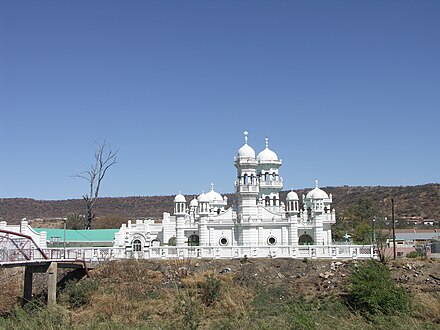Ladysmith - city in KwaZulu-Natal, South Africa
Ladysmith is a city in the KwaZulu-Natal province of South Africa at the foot of the Drakensberg mountains.
For other places with the same name, see Ladysmith (disambiguation).
Understand
History
Famous people show up in the most unexpected places
Sir Winston Churchill was reporter for the London Morning Post in Ladysmith at the time of the siege and Mohandas Gandhi was a stretcher bearer for the British Forces after the siege.
The Anglo Boer War dominates recorded history in this area. On 30 October 1899 (Mournful Monday), Boer forces started a siege on the town after British troops retreated there following their defeat at the Battle of Modderstroom. The siege lasted 118 days before British reinforcements arrived and were able to put an end to it.
Sir Winston Churchill gives a good account of the siege (and of the Anglo Boer War in general) in his book London to Ladysmith via Pretoria.
Get in
By car
Follow the N11 from the N3 for about 20km.
By train
Passenger trains between Johannesburg and Durban calls in Ladysmith.
- Ladysmith railway station, -28.5579°, 29.7858°. 2022-03-06
By plane
- Ladysmith Airport (IATA: LAY), -28.58°, 29.753333°. General aviation only 2019-11-27
Get around
See


- Castor and Pollux, -28.5595°, 29.7810°. Twin British Howitzers used to defend the town during the Anglo Boer war.
- MOTH Museum, +27 36 637-3762. 10:00-14:00.
- Siege Museum, -28.5591°, 29.7807°, +27 36 637-2992, info@ladysmith.co.za. M-F 09:00-16:00; Sa 09:00-13:00.
- Soofie Mosque, -28.5705°, 29.7797°. Open for visitors 13:00-14:00 and 17:00-21:00. A beautiful mosque that has been declared a National Monument. Free
- Statue of Gandhi, Lord Vishnu Temple, -28.5613°, 29.7851°, +27 36 637-7777. Mohandas Gandhi was a stretcher bearer after the Siege of Ladysmith and during the Battle of Spioenkop.
- Wagon Hill/Platrand Monument and Museum, Wagon Hill/Platrand Battlefield, +27 36 637-2992, info@ladysmith.co.za. Daily 07:00-17:00. A monument and museum in memory of those who died during the Anglo Boer War R6

- Llandaff Oratory, Van Reenan (54 km NW of Ladysmith on N3), -28.3667°, 29.3833°. Possibly the smallest church in the world, with only 8 seats.
The Battlefields
-
Bloukrans Memorial (Weneen Massacre), -28.8505°, 29.8428°. In 1836 and 1837, the Voortrekkers entered Kwazulu-Natal from across the Drakensberg. On 6 February 1838 their leader, Piet Retief together with his entourage were murdered by Dingane, the Zulu king, after having negotiated a land settlement. Dingane then sent his warriors to "eliminate" all new settlers who had camped along the Tugela, Bloukrans and Bushman’s Rivers to claim the best farms. On 17 February 1838, the Zulu impis attacked the waiting ox-wagons and in all 453 people were slain. The monument commemorating their murder was erected in 1897. There are no visitor facilities at the site.
-
Siege of Ladysmith, 151 Murchison Street, Ladysmith (next door to the Ladysmith Town Hall), -28.5637°, 29.7825°, +27 36 637 2992. M-F 08:00-16:00, Sa 09:00-12:00. The second Anglo-Boer War broke out on 11 October 1899. The Boers, who had been massing on the border close to Volksrust, swarmed into the Natal Colony and by 2 November 1899 half the British forces in the Colony were trapped in Ladysmith, a town about 20 km north of the Tugela River. There are many memorials on the hills around Ladysmith, but the museum, which is housed in the old market building, is in the centre of the town. R11
-
Battle of Colenso, -28.7342°, 29.8225°. Colenso is located on the south bank of the Tugela River which, during the siege of Ladysmith, was effectively the "front line" between the two forces. The Battle of Colenso took place on 15 December 1899 when the British tried to force a crossing of the river. From the British point of view, the battle was a disaster, not only were 143 men killed, but 10 field guns were lost while the Boers lost eight men killed. Four Victoria Crosses were awarded on that day, one of them posthumously to Freddie Roberts, Lord Robert's son. The Robert E Stevenson Museum, originally the toll house for the bridge, has maps depicting the battle and gives directions to memorials and graveyards associated with both the Battle of Colenso and the Battle of Tugela Heights. The key to the museum is held at the Police Station which is next door.
-
Battle of Spion Kop, -28.65°, 29.5164°.
-
Battle of Tugela Heights, -28.6667°, 29.85°.
Do
- Spioenkop, 30km outside Ladysmith (Follow the N11 towards the N3, then follow the R616 towards Bergville, road signage will indicate Spioenkop from here), -28.65°, 29.5164°. Site of one of the bloodiest battles of the Anglo Boer War, mainly comprising British troops from the Lancashire Brigade. Winston Churchill, working as a war correspondent wrote, "Many of the wounds were of a horrible nature...." There are hiking trails through the complete battlefield (a map is available from the attendant), but be prepared for quite a walk; turn of the century battles covered quite a large area.
Buy
- Ladysmith Black-Mambazo. Get their recordings at of the music shops in the city.
Eat
Drink
Sleep
- Idwala Lodge, +27 78 803-5545, info@idwalalodge.co.za.
- Platrand Lodge, Fourie's Kraal Farm, next to the Ladysmith airfield (Follow the N11 to Ladysmith airfield and follow the signs), +27 36 631-0204, info@platrandlodge.co.za. From R600 for a double
- Royal Hotel, 140 Murchison Street, +27 36 637-2176. From R620 for a double Bed and Breakfast
Go next
- The Royal Natal National Park is an hour's drive away.
- Spioenkop Nature Reserve and dam
- Cathedral Peak and Champagne Castle in the Ukhahlamba Drakensberg Park